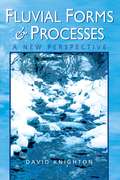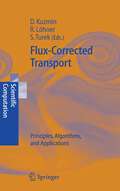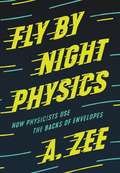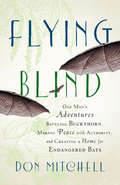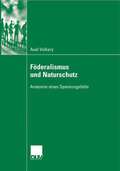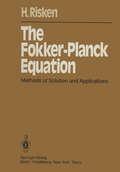- Table View
- List View
Fluvial Forms and Processes: A New Perspective
by David KnightonDavid Knighton's best-selling book looks at the wide range of forms developed by natural rivers and the processes responsible for that development. The book combines empirical and theoretical approaches, and provides a critical assessment of the many schools of thought which have emerged for dealing with adjustment in the fluvial system. It is fully illustrated throughout by a superb range of figures, photographs and tables.Starting with the network scale, the book examines the interaction of hillslopes, drainage networks and channels, and goes on to considerations of catchment hydrology and catchment denudation. Fluvial processes are analysed in detail, from the mechanics of flow to sediment transport and deposition. Detailing the major components of river channels, the book examines the nature of river adjustment, particularly with respect to equilibrium concepts, and concludes with a look at channel changes through time, affected by flood discharges, climatic change and human activities.
Fluvial Geomorphology of Great Britain (Geological Conservation Review Series)
by Ken J. GregoryFluvial Geomorphology of Great Britain studies the development of river-made land forms, together with the associated fluvial processes. There are many sites of scientific interest and value throughout the UK. The GCR sites described in this volume represent the wide range of fluvial land forms in the UK, and the accounts provide scientific descriptions of all the fluvial geomorphology sites in Britain selected for statutory nature conservation as SSSIs.
Fluvial Hydraulics
by S. Lawrence DingmanFluvial Hydraulics provides a sound qualitative and quantitative understanding of water and sediment flows in natural rivers. This understanding is essential for modeling and predicting hydrologic and geomorphologic processes, erosion, sediment transport, water supply and quality, habitat management, and flood hazards. This book's coverage bridges the gap between the highly quantitative mechanics-based civil-engineering approach to stream hydraulics and the more qualitative treatments of fluvial geomorphology typical of earth-sciences and natural-resources curricula. Measurements of natural river flows illustrate many central concepts. The book is specifically designed for upper-level students and practitioners who are interested in a fundamental understanding of river behavior. An introduction to the history of fluvial hydraulics and an overview of the morphology and hydrology of rivers provides the context for the rest of the text. A thorough understanding of water properties, including turbulence, is developed via a series of simple thought experiments. The bases of the equations that are used to describe and predict river flows are systematically presented, including dimensional analysis. Subsequent chapters build logically on these foundations, covering velocity distributions, new insights to the central topic of flow resistance, the magnitudes of forces in natural river flows, the principles of conservation of energy and momentum, the prediction of water-surface profiles, the principles of flow measurement, mechanics, and geomorphic aspects of sediment transport. The book will be especially valuable in providing a scientific basis for the growing field of river restoration. An appendix reviews dimenstions, units, and numerical precision. Over 250 references are cited, providing an entree to the extensive multi-disciplinary literature on rivers. The book's website provides suggestions for student exercises and makes available extensive data bases of measured streamflows for student exploration.
Fluvial Hydrodynamics: Hydrodynamic and Sediment Transport Phenomena (GeoPlanet: Earth and Planetary Sciences)
by Subhasish DeyThe state-of-the-art in fluvial hydrodynamics can be examined only through a careful exploration of the theoretical development and applied engineering technology. The book is primarily focused, since most up-to-date research findings in the field are presented, on the research aspects that involve a comprehensive knowledge of sediment dynamics in turbulent flows. It begins with the fundamentals of hydrodynamics and particle motion followed by turbulence characteristics related to sediment motion. Then, the sediment dynamics is analysed from a classical perspective by applying the mean bed shear approach and additionally incorporating a statistical description for the role of turbulence. The work finally examines the local scour problems at hydraulic structures and scale models. It is intended to design as a course textbook in graduate / research level and a guide for the field engineers as well, keeping up with modern technological developments. Therefore, as a simple prerequisite, the background of the readers should have a basic knowledge in hydraulics in undergraduate level and an understanding of fundamentals of calculus.
Fluvial Hydrosystems
by C. Amoros G. E. PettsFluvial Hydrosystems provides a unified approach to the study of running waters and aims to provide a scientific basis for sustainable management of rivers. It differs from traditional texts in viewing rivers as structured, four-dimensional systems and integrating ecological and geomorphological approaches to provide a holistic perspective on river dynamics. Advanced students of geomorphology, ecology, environmental science, land use and civil engineering will all benefit from this wide-ranging and stimulating textbook.
Fluvial Meanders and Their Sedimentary Products in the Rock Record (International Association Of Sedimentologists Series)
by Massimiliano Ghinassi Luca Colombera Nigel Mountney Arnold Jan H. ReesinkThe sinuous form and peculiar evolution of meandering rivers has long captured the imagination of people. Today, meandering rivers exist in some of the most densely populated areas in the World, where they provide environmental and economic wealth and opportunities, as well as posing hazards. Through geological time, the ancestors of these modern meanders built deposits that are now host to mineral resources, groundwater, and hydrocarbons. This Special Publication illustrates the breadth of current research on meandering rivers and their deposits. The collection of research papers demonstrates the state of science on fluvial process–product relationships. The articles cover fundamental and applied studies of both modern and ancient rivers, are based on state-of-the-art technology, include complementary philosophical approaches, and span a wide range of spatial and temporal scales. This book includes some of the most recent advances in the study of the morphodynamics and sedimentology of meandering rivers, and is an important resource for those who want to investigate fluvial systems and their deposits.
Fluvial Meanders and Their Sedimentary Products in the Rock Record (International Association Of Sedimentologists Series)
by Massimiliano Ghinassi Luca Colombera Nigel P. Mountney Arnold Jan H. Reesink Mark BatemanThe sinuous form and peculiar evolution of meandering rivers has long captured the imagination of people. Today, meandering rivers exist in some of the most densely populated areas in the World, where they provide environmental and economic wealth and opportunities, as well as posing hazards. Through geological time, the ancestors of these modern meanders built deposits that are now host to mineral resources, groundwater, and hydrocarbons. This Special Publication illustrates the breadth of current research on meandering rivers and their deposits. The collection of research papers demonstrates the state of science on fluvial process–product relationships. The articles cover fundamental and applied studies of both modern and ancient rivers, are based on state-of-the-art technology, include complementary philosophical approaches, and span a wide range of spatial and temporal scales. This book includes some of the most recent advances in the study of the morphodynamics and sedimentology of meandering rivers, and is an important resource for those who want to investigate fluvial systems and their deposits.
Fluvial Processes: Volume 1: Drivers and Conditions of River Channel Character and Change
by Roman S. ChalovThis book presents an overview of the fluvial processes theory developed in the former USSR at Lomonosov Moscow State University for the last 50 years, following the famous manuscript by Professor Makkaveev in 1955. Even being published solely in the Russian language, the theory and the author of the book, Prof. Roman Chalov, are well known in the World. This book consolidates for the first time in English, Chalov's work for the global audience.The book demonstrates how principles from fluvial geomorphology and hydrology are used to develop an ecosystem approach to river analysis and management. Despite a strong tradition in fluvial geomorphology work in the USSR, unfortunately, little has been made of insights provided on the international stage. The fluvial processes theory accepted in USSR was somewhat isolated during the long period of development from the English-language literature. The studied rivers are mostly located in Northern Eurasia and much different from those described in classical English-language works. Chalov allows the readers to interconnect two Worlds in Geomorphology, building bridges between the classical international geomorphology and the equally in-depth and thorough but isolated research in the USSR.
Fluvial Sedimentology VI (International Association Of Sedimentologists Series #26)
by Norman D. Smith John RogersUnderstanding of rivers and their sediments, both as modern systems and as ancient counterparts in the geological record, has progressed steadily but markedly over the past several decades, with contributions by practitioners in diverse fields of geosciences and engineering. This book contains 31 papers, with authors from 13 countries, who participated in the Sixth International Conference on Fluvial Sedimentology held in Cape Town, South Africa, in 1977. True to the nature of these quadrennial conferences, the papers in this book discuss a broad range of fluvial subjects that include the character of bedforms and sediment transport in river channels, morphological and sedimentological features of modern fluvial environments, modern and ancient avulsions, internal and external controls on the behaviour of river systems, and the facies and architectural organization of alluvial deposits. A specialist volume detailing the latest advances in fluvial sedimentology. Authorship includes the leaders in the field. If you are a member of the International Association of Sedimentologists, for purchasing details, please see: http://www.iasnet.org/publications/details.asp?code=SP28
Fluvial Sedimentology VII (International Association Of Sedimentologists Series #20)
by Michael Blum Susan Marriott Suzanne LeclairIAS Special Publication 35, Fluvial Sedimentology VII, comprises of a series of peer-reviewed papers that were initially presented at the 7th International Conference on Fluvial Sedimentology, held in Lincoln, Nebraska on August 6-10, 2001. The 29 papers in this volume reflect the topical and geographic diversity of exciting research conducted by fluvial sedimentologists at the beginning of the 21st century. Themes represented in this volume include (a) flow, sediment transport, and bedform dynamics, (b) characteristics of modern fluvial landforms, environments and systems, (c) physical analogue and numerical modeling of fluvial systems, (d) the responses of Quaternary fluvial systems to climate change, active tectonics, and/or sea-level change, and (e) characteristics of pre-Quaternary fluvial deposits and evolution of pre-Quaternary fluvial systems.
Fluvial Systems in the Anthropocene: Process, Response and Modelling
by Aznarul Islam Prakriti Das Sandipan Ghosh Abarna Mukhopadhyay Ayan Das Gupta Arun Kumar SinghThis book addresses the various factors affecting fluvial systems, the processes governing them, system responses arising from human-nature interventions, and geospatial and geo-ecological modeling to understand system behaviour better and restore degraded ecosystems around the globe. Thanks to their hydrological and agro-ecological advantages, humans have settled along riverbanks since the dawn of civilization. Thus, the ancient "ecumene" (settlements) were located near major rivers worldwide. This legacy of river-based civilizations continues to this day in many forms. However, in the course of the 'Anthropocene' era, countless fluvial systems have been altered by human interventions in the form of large-scale dams and barrages, changes in land use and land cover, road-stream crossings, mining of sand and gravel, mushrooming of brickfield, expansion of modern agriculture, industrial growth, and urbanization. Thus, the present-day development pattern threatens fluvial systems, especially riverine morphology and ecosystems. In brief, human-induced morphological changes, water pollution, eutrophication, and related damages to aquatic organisms are the major threats to fluvial systems. Thus, maintaining the 'environmental flow' of the world's major rivers to preserve the proper functioning of riverine ecosystems and promote sustainable development is a global challenge.
Flux Coordinates and Magnetic Field Structure: A Guide to a Fundamental Tool of Plasma Theory (Scientific Computation)
by William D. D'haeseleer William N.G. Hitchon James D. Callen J. Leon ShohetFlux Coordinates and Magnetic Field Structure gives a systematic and rigorous presentation of the mathematical framework and principles underlying the description of magnetically confined fusion plasmas. After a brief treatment of vector algebra in curvilinear coordinate systems the book introduces concepts such as flux surfaces, rotational transforms, and magnetic differential equations. The various specific types of coordinate system are dealt with in detail. Researchers and advanced students in plasma physics, electromagnetics, and mathematical physics will greatly benefit from this useful guide and reference book.
Flux-Corrected Transport: Principles, Algorithms, and Applications (Scientific Computation)
by Dmitri Kuzmin, Rainald Löhner and Stefan TurekAddressing students and researchers as well as Computational Fluid Dynamics practitioners, this book is the most comprehensive review of high-resolution schemes based on the principle of Flux-Corrected Transport (FCT). The foreword by J.P. Boris and historical note by D.L. Book describe the development of the classical FCT methodology for convection-dominated transport problems, while the design philosophy behind modern FCT schemes is explained by S.T. Zalesak. The subsequent chapters present various improvements and generalizations proposed over the past three decades. In this new edition, recent results are integrated into existing chapters in order to describe significant advances since the publication of the first edition. Also, 3 new chapters were added in order to cover the following topics: algebraic flux correction for finite elements, iterative and linearized FCT schemes, TVD-like flux limiters, acceleration of explicit and implicit solvers, mesh adaptation, failsafe limiting for systems of conservation laws, flux-corrected interpolation (remapping), positivity preservation in RANS turbulence models, and the use of FCT as an implicit subgrid scale model for large eddy simulations.
Flux-Corrected Transport: Principles, Algorithms, and Applications (Scientific Computation)
by Dmitri Kuzmin Rainald Löhner Stefan TurekAddressing students and researchers as well as CFD practitioners, this book describes the state of the art in the development of high-resolution schemes based on the Flux-Corrected Transport (FCT) paradigm. Intended for readers who have a solid background in computational fluid dynamics, the book begins with historical notes by J.P. Boris and D.L. Book. Review articles that follow describe recent advances in the design of FCT algorithms as well as various algorithmic aspects. The topics addressed in the book and its main highlights include: the derivation and analysis of classical FCT schemes, with special emphasis on the underlying physical and mathematical constraints; flux limiting for hyperbolic systems; generalization of FCT to implicit time-stepping and finite element discretizations on unstructured meshes and its role as a subgrid scale model for Monotonically Integrated Large Eddy Simulation (MILES) of turbulent flows. The proposed enhancements of the FCT methodology also comprise the prelimiting and 'failsafe' adjustment of antidiffusive fluxes, the use of characteristic variables, and iterative flux correction. The cause and cure of detrimental clipping/terracing effects are discussed. Many numerical examples are presented for academic test problems and large-scale applications alike.
Fluxes of Carbon, Water and Energy of European Forests (Ecological Studies #163)
by Riccardo ValentiniAfter years of technological development and its important achievements to make our life easier and more comfortable, human society is going to face one of the most difficult challenges of the last century: to stabilize the concentra tion levels of greenhouse gases in the atmosphere to prevent harmful effects on the climate system. Through a delicate balance between photosynthesis and respiration, terres trial ecosystems, and in particular forests, are today thought to take up a sig nificant part of the carbon dioxide emissions in the atmosphere, sometimes called the "terrestrial carbon sink". However, the location, magnitude, and vulnerability of the carbon dioxide sink of the terrestrial biota are still uncer tain. The suite of traditional tools in an ecologist's toolbox for studying ecosys tem productivity and carbon balance include leaf cuvettes, whole-plant and soil chambers for gas exchange, and biomass and soil carbon inventories. While each of the cited methods has distinct advantages, they are limited with regards to their ability to measure net carbon dioxide exchange of the whole ecosystem across a variety of time scales. This book present a compendium of results of a European project (EURO FLUX), funded by the European Commission through its fourth framework program, aiming to elucidate the role of forests in continental carbon balance.
Fly and Be Damned: What Now for Aviation and Climate Change?
by Peter McMannersPeter McManners gets underneath the well-known facts about the unsustainable nature of the aviation industry and argues for fundamental change to our travelling habits. The first book to transcend the emotional debate between the entrenched positions of those who are either for, or against, flying, this groundbreaking work argues that aviation is stuck in a stalemate between misguided policy and a growing imperative to deal with its environmental impact and that there is now little possibility that the transition to sustainable flying can be a smooth evolution.
Fly and Be Damned: What Now for Aviation and Climate Change?
by Peter McMannersPeter McManners gets underneath the well-known facts about the unsustainable nature of the aviation industry and argues for fundamental change to our travelling habits. The first book to transcend the emotional debate between the entrenched positions of those who are either for, or against, flying, this groundbreaking work argues that aviation is stuck in a stalemate between misguided policy and a growing imperative to deal with its environmental impact and that there is now little possibility that the transition to sustainable flying can be a smooth evolution.
Fly Ash Zeolites: Innovations, Applications, and Directions (Advanced Structured Materials #78)
by Bhagwanjee Jha Devendra Narain SinghThis book presents a thorough review of the state-of-knowledge and recent innovations in the synthesis of pure and improved grades of fly ash zeolites (FAZ). Addressing improvements to conventional methods, it also showcases a novel technique for the synthesis of high cation exchangers from fly ash and detailed characterization techniques for the products obtained. In addition, it examines in detail various areas of specific applications of fly ash zeolites. Over the years, several methods such as hydrothermal, fusion prior to hydrothermal, microwave assisted hydrothermal and molten salt techniques for producing FAZ have been developed. However, one-step and two-step reactions between the fly ash and alkali usually generate alkaline wastes that may cause environmental contamination. In addition, the separation of FAZ from the partially activated fly ash (the impurities) remains a major concern for researchers and industrialists alike. In view of these challenges, this book presents a novel technique for three-step activation (TSA), which focuses on recycling the fly ash-NaOH-water reaction by-products until zeolitic residue is formed. The FAZ (the final residue after third step reactions) synthesized in this manner exhibits exceptionally high cation exchange capacity, specific surface area and pore area. This book offers a comprehensive compendium of reading material on fly ash and its recycled product, the zeolites. Students at both undergraduate and graduate levels, researchers, and practicing engineers will all find this book to be a valuable guide in their respective fields.
Fly by Night Physics: How Physicists Use the Backs of Envelopes
by A. ZeeThe essential primer for physics students who want to build their physical intuitionPresented in A. Zee's incomparably engaging style, this book introduces physics students to the practice of using physical reasoning and judicious guesses to get at the crux of a problem. An essential primer for advanced undergraduates and beyond, Fly by Night Physics reveals the simple and effective techniques that researchers use to think through a problem to its solution—or failing that, to smartly guess the answer—before starting any calculations.In typical physics classrooms, students seek to master an enormous toolbox of mathematical methods, which are necessary to do the precise calculations used in physics. Consequently, students often develop the unfortunate impression that physics consists of well-defined problems that can be solved with tightly reasoned and logical steps. Idealized textbook exercises and homework problems reinforce this erroneous impression. As a result, even the best students can find themselves completely unprepared for the challenges of doing actual research.In reality, physics is replete with back of the envelope estimates, order of magnitude guesses, and fly by night leaps of logic. Including exciting problems related to cutting-edge topics in physics, from Hawking radiation to gravity waves, this indispensable book will help students more deeply understand the equations they have learned and develop the confidence to start flying by night to arrive at the answers they seek. For instructors, a solutions manual is available upon request.
Flying Blind: One Man's Adventures Battling Buckthorn, Making Peace with Authority, and Creating a Home for Endangered Bats
by Don MitchellWhen Middlebury writing professor Don Mitchell was approached by a biologist with the Vermont Fish and Wildlife Department about tracking endangered Indiana bats on his 150-acre farm in Vermont's picturesque Champlain Valley, Mitchell's relationship with bats—and with government—could be characterized as distrustful, at best. But the flying rats, as Mitchell initially thinks of them, launched him on a series of "improvements" to his land that would provide a more welcoming habitat for the bats—and a modest tax break for himself and his family. Whether persuading his neighbors to join him on a "silent meditation," pulling invasive garlic mustard out of the ground by hand, navigating the tacit ground rules of buying an ATV off Craigslist, or leaving just enough honeysuckle to give government inspectors "something to find," Mitchell’s tale is as profound as it is funny—a journey that changes Mitchell’s relationship with Chiroptera, the land, and, ultimately, his understanding of his own past. Ruminating on the nature of authority, the purview of the state, and the value of inhabiting one’s niche—Mitchell reveals much about our inner and outer landscape, in this perfectly paced and skilled story of place.
Flyrock in Surface Mining: Origin, Prediction, and Control
by Autar K. RainaThis book provides a comprehensive understanding of historical and recent research, with a critical review of several aspects of the flyrock phenomenon, along with classification of pertinent literature. This puts flyrock into proper perspective and develops a comprehensive regime for flyrock prediction and control. It also addresses the blast danger zone demarcation based on scientific understanding in comparison to the consequence-based approach supported by pertinent case studies. Features: Discusses exclusive material on flyrock in surface mining. Presents comprehensive and critical review of the flyrock phenomenon. Reviews prediction and control mechanisms in vogue with scientific and risk-based definitions of blast danger zone. Provides new insights into the flyrock definitions, prediction, and prevention along with the research approach to the problem. Includes Indian case studies and summarize global data available in the published domain. This book is aimed at researchers and graduate students in mining and civil engineering, engineering geology, and blasting.
Flyrock in Surface Mining: Origin, Prediction, and Control
by Autar K. RainaThis book provides a comprehensive understanding of historical and recent research, with a critical review of several aspects of the flyrock phenomenon, along with classification of pertinent literature. This puts flyrock into proper perspective and develops a comprehensive regime for flyrock prediction and control. It also addresses the blast danger zone demarcation based on scientific understanding in comparison to the consequence-based approach supported by pertinent case studies. Features: Discusses exclusive material on flyrock in surface mining. Presents comprehensive and critical review of the flyrock phenomenon. Reviews prediction and control mechanisms in vogue with scientific and risk-based definitions of blast danger zone. Provides new insights into the flyrock definitions, prediction, and prevention along with the research approach to the problem. Includes Indian case studies and summarize global data available in the published domain. This book is aimed at researchers and graduate students in mining and civil engineering, engineering geology, and blasting.
Föderalismus und Naturschutz: Anatomie eines Spannungsfelds
by Axel VolkeryAxel Volkery zeigt, dass trotz guter Ansätze viele Problemstellungen nicht richtig angegangen werden und die rechtliche Umsetzung in den Bundesländern defizitär ausfällt, der Spielraum für Reformen in der Politikverflechtung strukturell begrenzt und die Stärkung der Kompetenzen des Bundes notwendig ist und die jüngst vorgenommene Neuregelung der Kompetenzen von Bund und Ländern im Naturschutz die notwendige Leistungssteigerung erschweren wird.
Fog and Boundary Layer Clouds: Fog Visibility and Forecasting (Pageoph Topical Volumes)
by Ismail GultepeThis topical volume of the Journal of Pure and Applied Geophysics utilizes new information not previously accessible for fog related research. It focuses on surface and remote sensing observations of fog, various numerical model applications using new parameterizations, fog climatology, and new statistical methods. The results presented in this special issue come from research efforts in North America and Europe.
The Fokker-Planck Equation: Methods of Solution and Applications (Springer Series in Synergetics #18)
by Hannes RiskenOne of the central problems synergetics is concerned with consists in the study of macroscopic qualitative changes of systems belonging to various disciplines such as physics, chemistry, or electrical engineering. When such transitions from one state to another take place, fluctuations, i.e., random processes, may play an im portant role. Over the past decades it has turned out that the Fokker-Planck equation pro vides a powerful tool with which the effects of fluctuations close to transition points can be adequately treated and that the approaches based on the Fokker Planck equation are superior to other approaches, e.g., based on Langevin equa tions. Quite generally, the Fokker-Planck equation plays an important role in problems which involve noise, e.g., in electrical circuits. For these reasons I am sure that this book will find a broad audience. It pro vides the reader with a sound basis for the study of the Fokker-Planck equation and gives an excellent survey of the methods of its solution. The author of this book, Hannes Risken, has made substantial contributions to the development and application of such methods, e.g., to laser physics, diffusion in periodic potentials, and other problems. Therefore this book is written by an experienced practitioner, who has had in mind explicit applications to important problems in the natural sciences and electrical engineering.
